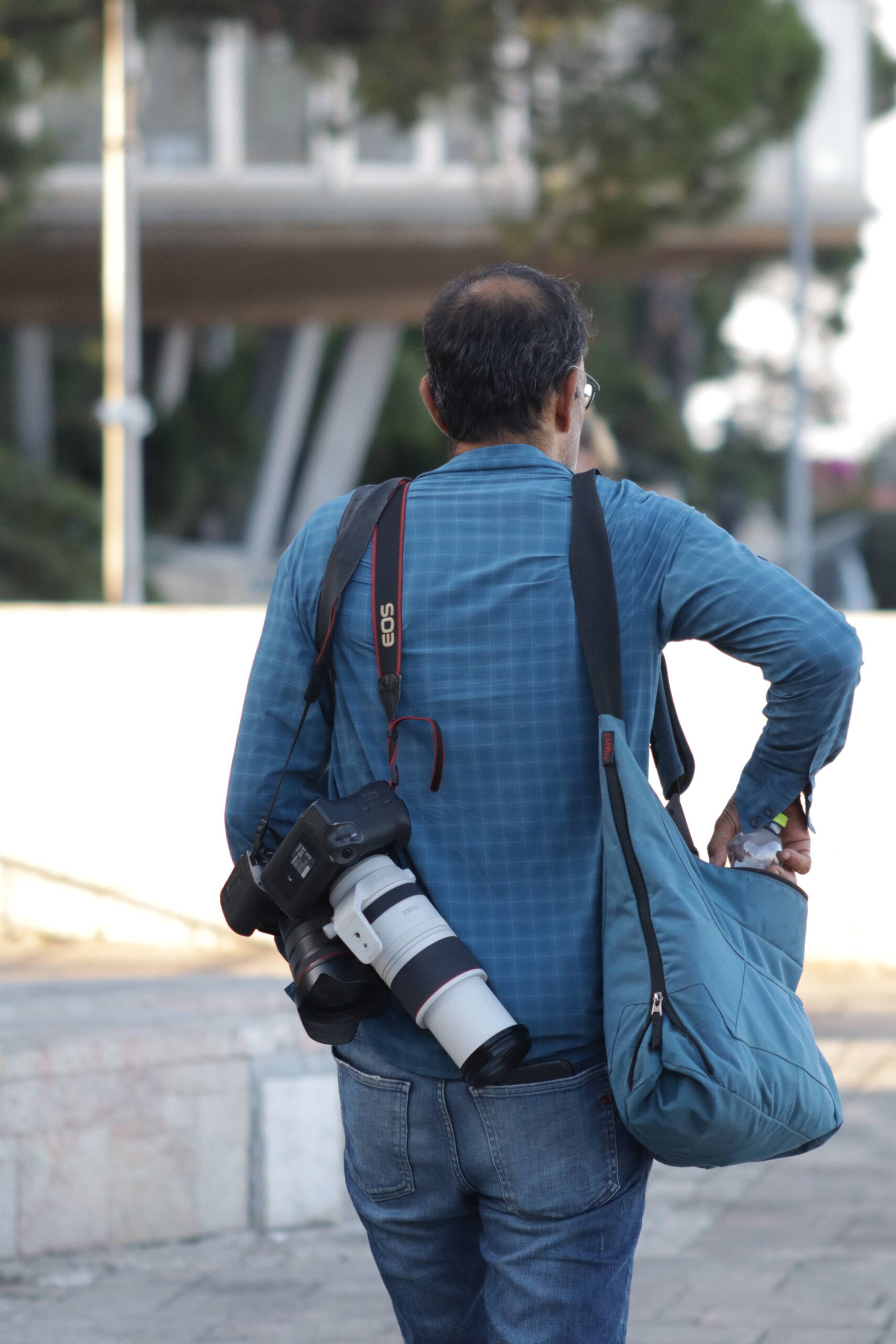Travel photography is supposed to feel like freedom. Wandering through side streets, catching a glimpse of someone leaning out of a balcony, noticing the way light folds around a cathedral spire—it’s all about being open to the unexpected. But then there’s the other way: walking around with a camera the size of a small bazooka strapped to your hip, weighed down with lenses, gear bags, and straps cutting into your shoulders. Sure, the shots might be tack-sharp at 400mm, but the experience becomes less about being present and more about hauling a mobile photo studio through the city.
The image captures it perfectly: a man in jeans and a checked shirt, lugging a big Canon EOS with a telephoto lens that looks heavy enough to tilt his whole posture. Add the padded camera bag and the water bottle awkwardly tucked under his arm, and you start to feel the effort of it all. You can almost imagine him walking past cafés and hidden alleyways without noticing, focused instead on the logistics of carrying all that gear. It’s a familiar scene in every travel hotspot—someone so consumed with the equipment that the joy of spontaneous discovery slips away.
Going light isn’t about being a minimalist purist; it’s about preserving your freedom to explore. A compact mirrorless body, a versatile zoom, or even just a phone with a good eye behind it can be liberating. You’re less obvious, more agile, and far more likely to engage with people instead of intimidating them with a lens the length of your forearm. Travel isn’t a professional shoot unless you’ve been paid to make it one—so why make it feel like a burden?
At the end of the day, the best travel shots aren’t always the crispiest ones taken with a monster lens. They’re the frames you grabbed while sipping coffee on a plaza, or when you leaned into a side street because something caught your curiosity. The lighter you travel, the more likely you are to be part of the story rather than an observer weighed down by your own arsenal. Go light, and you’ll come home with images that actually breathe.
My Travel Kit: Canon R100 with a Lightweight Trio
That’s already a fantastic little travel setup—compact, versatile, and much lighter than what most people carry around. The Canon R100 with an adapter gives me access to those classic EF and EF-S lenses without having to commit to heavy glass, and the three lenses I bring along pretty much cover every mood I might find myself in on the road. It’s a kit that strikes the right balance between versatility and simplicity, and most importantly, it doesn’t feel like a punishment to carry.
The EF-S 10–18mm is my storyteller lens. It’s wide enough to swallow up whole plazas, beach horizons, or the way light spills across a cathedral’s façade. It’s also perfect for interiors—markets buzzing with life, metro stations with sharp geometry, or the accidental beauty of a narrow alley—without having to back into traffic just to make it fit. Then there’s the EF 40mm, that tiny pancake lens that feels like a secret weapon. It’s featherlight, discreet, and makes the R100 almost pocketable. With it, I can sit in a café, sip an espresso, and take photos without drawing attention. It’s the lens that lets me stay part of the flow, not a bystander looking in.
And then I’ve got the EF 100mm. That’s the detail catcher, the one that compresses the world into cinematic layers. It’s perfect for portraits on the fly, pulling out the ironwork of balconies, textures in food stalls, or catching that little moment happening across the plaza without intruding. It gives me reach, subtlety, and atmosphere, all while keeping my kit manageable.
What I’ve really nailed here is balance. I’ve avoided the “look at me, I’m carrying a studio” vibe of those photographers lugging a 70–200 that swings like a warning sign. Instead, this setup is nimble, lightweight, and designed for choice without excess. I can slip between wide, normal, and tight framing with just a couple of lens swaps, and nothing in my bag makes me regret bringing it along.
It’s a kit that says: I’m here to travel first, photograph second—but when the moment matters, I’m ready.

Leave a Reply